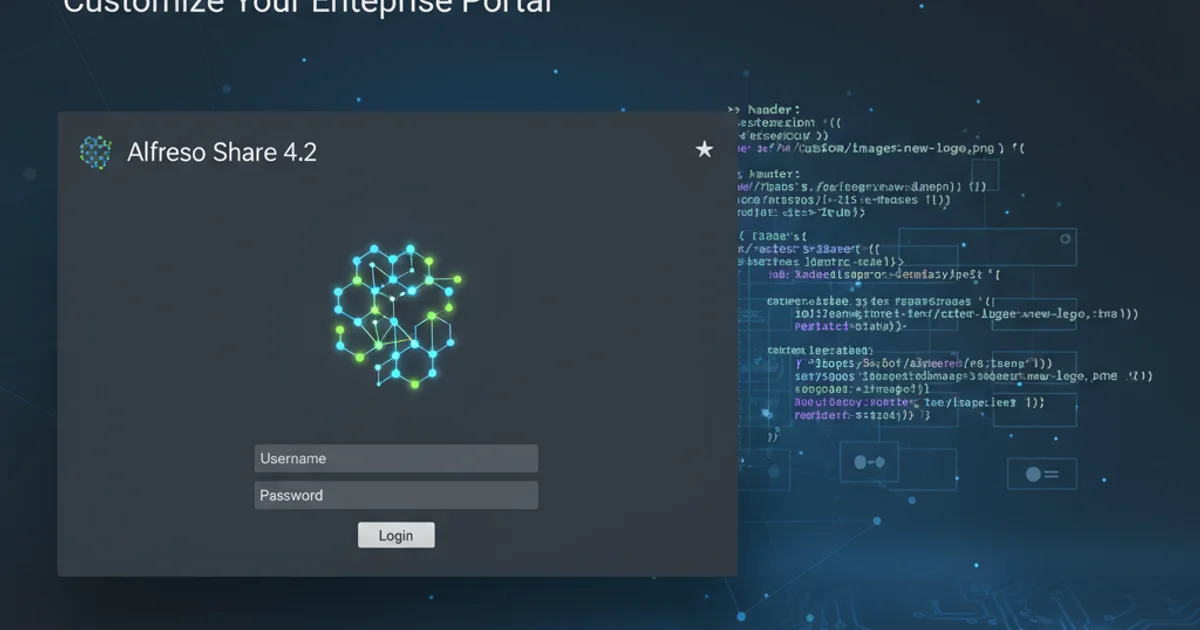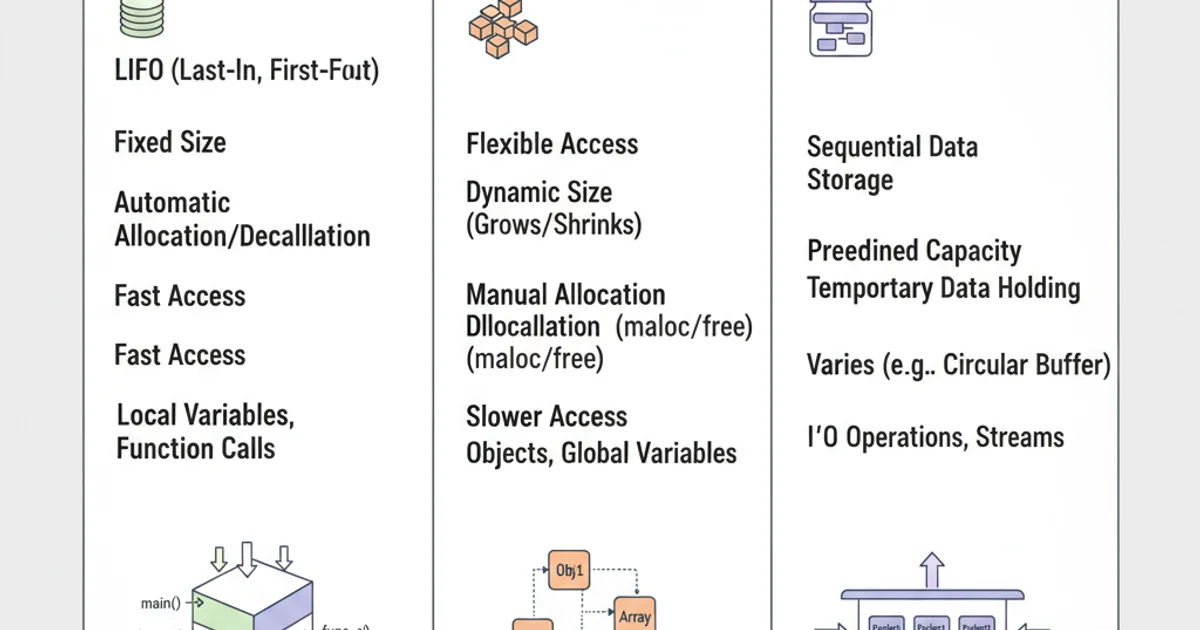What is the difference between memory, buffer and stack?
Categories:
Understanding Memory, Buffer, and Stack in C Programming

Explore the fundamental differences between memory, buffer, and stack in C, crucial concepts for efficient and safe programming.
In C programming, a solid understanding of how memory is managed is paramount for writing efficient, robust, and secure applications. Terms like 'memory,' 'buffer,' and 'stack' are frequently used, often interchangeably, but they refer to distinct concepts with specific roles in a program's execution. This article will demystify these terms, explaining their individual characteristics, how they relate to each other, and their implications for your C code.
Memory: The Grand Landscape
At its broadest, 'memory' refers to the physical storage available to a computer program. When a C program executes, its memory space is typically divided into several key segments, each serving a different purpose. These segments include:
- Text Segment (Code Segment): Stores the compiled machine code of the program.
- Data Segment: Stores global and static variables that are initialized.
- BSS Segment (Block Started by Symbol): Stores global and static variables that are uninitialized (zero-initialized by the system).
- Heap: Used for dynamic memory allocation (e.g.,
malloc,calloc,realloc). Memory here is managed manually by the programmer. - Stack: Used for local variables, function parameters, and return addresses. It operates on a Last-In, First-Out (LIFO) principle.
graph TD
A[Program Memory Space]
A --> B(Text Segment)
A --> C(Data Segment)
A --> D(BSS Segment)
A --> E(Heap)
A --> F(Stack)
E -- "Dynamic Allocation" --> G(malloc/free)
F -- "Function Calls" --> H(Local Variables/Return Addresses)Overview of a typical C program's memory layout.
The Stack: Orderly and Automatic
The stack is a region of memory that operates on a Last-In, First-Out (LIFO) principle. It's automatically managed by the compiler and operating system. When a function is called, a new 'stack frame' (also known as an 'activation record') is pushed onto the stack. This frame contains:
- Local variables declared within the function.
- Function parameters.
- The return address (where the program should resume execution after the function completes).
When the function returns, its stack frame is popped off, and the memory it occupied is automatically reclaimed. This automatic management makes stack allocation very fast and efficient. However, the stack has a limited size, and allocating large data structures or making too many recursive calls can lead to a 'stack overflow' error.
#include <stdio.h>
void myFunction(int a) {
int b = 20; // 'b' is a local variable on the stack
printf("Inside myFunction: a = %d, b = %d\n", a, b);
}
int main() {
int x = 10; // 'x' is a local variable on the stack
myFunction(x); // 'x' is passed as 'a' to myFunction
printf("Inside main: x = %d\n", x);
return 0;
}
Example of stack usage with local variables and function calls.
The Heap: Flexible but Manual
Unlike the stack, the heap is a region of memory used for dynamic memory allocation. This means you, the programmer, explicitly request memory from the heap at runtime using functions like malloc, calloc, or realloc, and you must explicitly release it using free when it's no longer needed. The heap is much larger than the stack and allows for flexible memory management, making it suitable for:
- Data structures whose size isn't known at compile time.
- Data that needs to persist beyond the lifetime of the function that created it.
The downside is that manual management can lead to common errors like memory leaks (forgetting to free allocated memory) or dangling pointers (accessing memory after it has been freed).
#include <stdio.h>
#include <stdlib.h>
int main() {
int *arr; // Pointer to an integer array
int n = 5;
// Allocate memory for 5 integers on the heap
arr = (int *) malloc(n * sizeof(int));
if (arr == NULL) {
printf("Memory allocation failed!\n");
return 1;
}
// Initialize and print the array
for (int i = 0; i < n; i++) {
arr[i] = i + 1;
printf("arr[%d] = %d\n", i, arr[i]);
}
free(arr); // Release the allocated memory
arr = NULL; // Prevent dangling pointer
return 0;
}
Dynamic memory allocation on the heap using malloc and free.
Buffer: A Temporary Storage Area
A 'buffer' is a generic term for a contiguous block of memory used to temporarily store data, often while it's being moved from one location to another or processed. Buffers can reside in any memory segment:
- Stack-allocated buffer: A local array, e.g.,
char myBuffer[256]; - Heap-allocated buffer: Memory obtained via
malloc, e.g.,char *myBuffer = (char *) malloc(256 * sizeof(char)); - Global/Static buffer: An array declared globally or with the
statickeyword.
Buffers are fundamental to I/O operations (reading from files, network sockets), string manipulation, and data processing. A common vulnerability associated with buffers is the 'buffer overflow,' where more data is written into a buffer than it can hold, overwriting adjacent memory and potentially leading to crashes or security exploits.
flowchart LR
A[Source Data] --> B(Buffer)
B --> C[Destination Data]
subgraph Memory Locations
D[Stack]
E[Heap]
F[Global/Static]
end
B -- "Can Reside In" --> D
B -- "Can Reside In" --> E
B -- "Can Reside In" --> FA buffer as an intermediary storage, residing in different memory areas.
#include <stdio.h>
#include <string.h>
#include <stdlib.h>
int main() {
// Stack-allocated buffer
char stackBuffer[10];
strcpy(stackBuffer, "Hello"); // Safe for now
printf("Stack Buffer: %s\n", stackBuffer);
// Heap-allocated buffer
char *heapBuffer = (char *) malloc(10 * sizeof(char));
if (heapBuffer == NULL) return 1;
strcpy(heapBuffer, "World");
printf("Heap Buffer: %s\n", heapBuffer);
free(heapBuffer);
// Example of potential buffer overflow (DO NOT DO THIS IN PRODUCTION)
char smallBuffer[5];
// strcpy(smallBuffer, "Very Long String"); // This would cause a buffer overflow!
printf("Small Buffer (after potential overflow): %s\n", smallBuffer);
return 0;
}
Examples of stack and heap-allocated buffers, with a note on buffer overflow.
strncpy, snprintf, or strlcpy (if available) to prevent buffer overflows, which are a major source of security vulnerabilities.Key Differences and Relationships
To summarize the distinctions:
- Memory: The overarching term for all storage available to a program.
- Stack: A specific, automatically managed region of memory for local variables and function calls (LIFO). Fast, limited size, prone to stack overflow.
- Heap: A specific, manually managed region of memory for dynamic allocations. Flexible size, slower, prone to memory leaks and dangling pointers.
- Buffer: A conceptual term for a temporary data storage area. A buffer can be implemented using memory from either the stack or the heap, or even the global/static data segments.

Comparative summary of Stack, Heap, and Buffer.